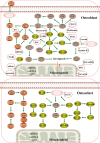Mitochondrial quality control and its role in osteoporosis
- PMID: 36793284
- PMCID: PMC9922754
- DOI: 10.3389/fendo.2023.1077058
Mitochondrial quality control and its role in osteoporosis
Abstract
Mitochondria are important organelles that provide cellular energy and play a vital role in cell differentiation and apoptosis. Osteoporosis is a chronic metabolic bone disease mainly caused by an imbalance in osteoblast and osteoclast activity. Under physiological conditions, mitochondria regulate the balance between osteogenesis and osteoclast activity and maintain bone homeostasis. Under pathological conditions, mitochondrial dysfunction alters this balance; this disruption is important in the pathogenesis of osteoporosis. Because of the role of mitochondrial dysfunction in osteoporosis, mitochondrial function can be targeted therapeutically in osteoporosis-related diseases. This article reviews different aspects of the pathological mechanism of mitochondrial dysfunction in osteoporosis, including mitochondrial fusion and fission, mitochondrial biogenesis, and mitophagy, and highlights targeted therapy of mitochondria in osteoporosis (diabetes induced osteoporosis and postmenopausal osteoporosis) to provide novel targets and prevention strategies for the prevention and treatment of osteoporosis and other chronic bone diseases.
Keywords: mitochondrial autophagy; mitochondrial biogenesis; mitochondrial fusion and fission; osteoporosis; targeted therapy.
Copyright © 2023 Yan, Shi, Yuan, Lv, Sun, Wang, Liu and An.
Conflict of interest statement
The authors declare that the research was conducted in the absence of any commercial or financial relationships that could be construed as a potential conflict of interest.
Figures





References
-
- Chen L, Shi X, Xie J, Weng SJ, Xie ZJ, Tang JH, et al. . Apelin-13 induces mitophagy in bone marrow mesenchymal stem cells to suppress intracellular oxidative stress and ameliorate osteoporosis by activation of AMPK signaling pathway. Free Radic Biol Med (2021) 163:356–68. doi: 10.1016/j.freeradbiomed.2020.12.235 - DOI - PubMed
Publication types
MeSH terms
LinkOut - more resources
Full Text Sources
Other Literature Sources
Medical

